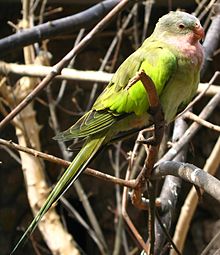Princess parrot
| Princess parrot | |
|---|---|

| |
| Scientific classification | |
| Domain: | Eukaryota |
| Kingdom: | Animalia |
| Phylum: | Chordata |
| Class: | Aves |
| Order: | Psittaciformes |
| Family: | Psittaculidae |
| Genus: | Polytelis |
| Species: | P. alexandrae
|
| Binomial name | |
| Polytelis alexandrae Gould, 1863
| |
The colourful princess parrot (Polytelis alexandrae) is an Australian bird of the
Description

The princess parrot is a medium-sized parrot, 34 to 46 cm long and weighing between 110 and 120 g. The plumage is mostly green with a pink throat, bluish crown, and bright green shoulders. The rump is blue and the tail is long and narrow. The males have longer tail feathers and brighter coloring than females. The male also has a coral-red beak, while the female's is duller and has a greyish crown. Another difference is that the male has an orange iris, while the female's is much browner. In addition, the male of the species has a longer, projecting extension from the end of the 3rd primary (flight) feather on each side. This projection is called a 'spatula' or 'spatule' and appears in mature male birds.[citation needed]
Behaviour
This species is
behaviour against predators. They feed on the seeds of grasses and shrubs.Breeding
Four to six white eggs are laid which are incubated for 19 days. The chicks leave the nest about 35 days after hatching. These parakeets are truly

Aviculture
The princess parrot can make loud calls.
There are three common color mutations of this parakeet. These colours are Lutino, Blue, and Albino (combination of Blue and Lutino). The natural, or 'normal' color is green. There are two types of blue, one blue winged and the second is bright blue wings and bright blue head.

References
- . Retrieved 7 February 2023.
- ^ ISBN 1-84309-164-X.
- ^ "Princess Of Wales Parakeet Birds". www.birdchannel.com. Retrieved 2015-10-19.
External links
- World Parrot Trust Parrot Encyclopedia - Species Profiles

